Reservoir Space Characterization of Ordovician Wulalike Formation in Northwestern Ordos Basin, China
Abstract
:1. Introduction
2. Geological Setting
3. Materials and Methods
3.1. Materials for Fracture Identification and Characterization
3.2. Methods for Fracture Identification and Characterization
4. Results
4.1. Reservoir Space Types
4.2. Fracture Characteristic from Core Observation
4.3. Fracture Characteristic in NMR Spectra
4.4. Fracture Characteristic from Deep and Shallow Resistivity Responses
4.5. Reservoir Space Composition
5. Implications
6. Conclusions
Author Contributions
Funding
Acknowledgments
Conflicts of Interest
References
- Zou, C.; Dong, D.; Wang, S.; Li, J.; Li, X.; Wang, Y.; Li, D.; Cheng, K. Geological characteristics and resource potential of shale gas in China. Pet. Explor. Dev. 2010, 37, 641–653. [Google Scholar] [CrossRef]
- Ma, Y.; Cai, X.; Zhao, P. China’s shale gas exploration and development: Understanding and practice. Pet. Explor. Dev. 2018, 45, 589–603. [Google Scholar] [CrossRef]
- Zhao, W.; Jia, A.; Wei, Y.; Wang, J.; Zhu, H. Progress in shale gas exploration in China and prospects for future development. China Pet. Explor. 2020, 25, 31. [Google Scholar]
- Magoon, L.B.; Dow, W.G. (Eds.) The petroleum system. In The Petroleum System—From Source to Trap; American Association of Petroleum Geologists Memoir: Tulsa, OK, USA, 1994; pp. 3–24. [Google Scholar]
- Law, B.E.; Curtis, J.B. Introduction to unconventional petroleum systems. AAPG Bull. 2002, 86, 1851–1852. [Google Scholar]
- Katz, B.; Gao, L.; Little, J.; Zhao, Y. Geology still matters—Unconventional petroleum system disappointments and failures. Unconv. Resour. 2021, 1, 18–38. [Google Scholar] [CrossRef]
- Peters, K.E.; Cassa, M.R. Applied source rock geochemistry. In The Petroleum System—From Source to Trap; Magoon, L.B., Dow, W.G., Eds.; American Association of Petroleum Geologists Memoir: Tulsa, OK, USA, 1994; pp. 93–120. [Google Scholar]
- Passey, Q.R.; Bohacs, K.M.; Esch, W.L.; Klimentidis, R.; Sinha, S. From oil-prone source rock to gas-producing shale reservoir—Geologic and petrophysical characterization of unconventional shale-gas reservoirs. In SPE International Oil and Gas Conference and Exhibition in China; SPE: Calgary, AB, Canada, 2010; p. SPE-131350. [Google Scholar]
- Burton, Z.F.; Moldowan, J.M.; Sykes, R.; Graham, S.A. Unraveling petroleum degradation, maturity, and mixing and addressing impact on petroleum prospectivity: Insights from frontier exploration regions in New Zealand. Energy Fuels 2018, 32, 1287–1296. [Google Scholar] [CrossRef]
- Burton, Z.F.M.; Moldowan, J.M.; Magoon, L.B.; Sykes, R.; Graham, S.A. Interpretation of source rock depositional environment and age from seep oil, east coast of New Zealand. Int. J. Earth Sci. 2019, 108, 1079–1091. [Google Scholar] [CrossRef]
- Singh, P.; Slatt, R.; Borges, G.; Perez, R.; Portas, R.; Marfurt, K.; Ammerman, M.; Coffey, W. Reservoir Characterization of Unconventional Gas Shale Reservoirs: Example from the Barnett Shale, Texas, USA; AAPG: Tulsa, OK, USA, 2009; Viingepet 2008 EXPL-1-RS-124. [Google Scholar]
- Burton, Z.F.; McHargue, T.; Kremer, C.H.; Bloch, R.B.; Gooley, J.T.; Jaikla, C.; Harrington, J.; Graham, S.A. Peak Cenozoic warmth enabled deep-sea sand deposition. Sci. Rep. 2023, 13, 1276. [Google Scholar] [CrossRef]
- Pang, M.; Ba, J.; Deng, J.; Müller, T.M.; Saenger, E.H. Rock-physics Template Based on Differential Diagenesis for the characterization of shale gas reservoirs. Arab. J. Sci. Eng. 2023, 48, 677–693. [Google Scholar] [CrossRef]
- Xi, S.; Liu, X.; Huang, Z.; Zhao, H.; Zhang, C.; Liu, Y. Enrichment characteristics and exploration direction of shale oil and gas in Wulalike Formation of Middle Ordovician in the Ordos Basin. Nat. Gas Ind. 2023, 43, 12–22. [Google Scholar]
- Wu, D.; Wu, X.; Li, C.; Yu, Z.; Li, W.; Cai, J.; Li, G. Sedimentary model and hydrocarbon-generation potential of source rock of the Ordovician Ulalik Formation in western Ordos Basin. Mar. Oil Gas Geol. 2021, 26, 123–130. [Google Scholar]
- Zhang, Y.; Guo, Y.; Hou, W.; Zhao, Z.; Gao, J. Geochemical Characteristics and Exploration Potential of the Middle-Upper Ordovician Source Rocks on the Western and Southern Margin of Ordos Basin. Nat. Gas Geosci. 2013, 24, 894–904. [Google Scholar]
- He, Z. Tectonic Evolution and Oil and Gas Resources in Ordos Basin; Petroleum Industry Press: Beijing, China, 2003; pp. 3–152. [Google Scholar]
- Deng, K.; Zhou, W.; Deng, H.; Wan, Y.; Deng, H.; Xie, R.; Chen, W. Geological conditions for accumulation of shale gas in Middle Ordovician Pingliang Formation of Ordos Basin, China. J. Chengdu Univ. Technol. (Sci. Technol. Ed.) 2013, 40, 595–602. [Google Scholar]
- Sun, Y.; Wang, C.; Wang, Y.; Yang, W.; Xu, H.; Liu, W.; Wu, T. Geochemical characteristics and exploration potential of Middle Ordovician Pingliang Formation in the Ordos Basin. Pet. Geol. Exp. 2008, 30, 162–168. [Google Scholar]
- Zhao, J.; Wang, D.; Sun, L.; Bao, H.; Xiao, H.; Wu, W.; Chen, Y. Origin of the Ordovician gas and its accumulation patterns in northwestern Ordos Basin. Oil Gas Geol. 2015, 36, 711–720. [Google Scholar]
- Deng, K.; Zhou, W.; Zhou, L.; Wan, Y.; Deng, H.; Xie, R.; Chen, W. Influencing factors of micropores in the graptolite shale of Ordovician Pingliang Formation in Ordos Basin, China. Pet. Explor. Dev. 2016, 43, 378–385. [Google Scholar] [CrossRef]
- Du, J.; Li, X.; Bao, H.; Xu, W.; Wang, Y.; Huang, J.; Wang, H.; Rong, W.; Wang, J. Geological conditions of natural gas accumulation and new exploration areas in the Mesoproterozoic to Lower Paleozoic of Ordos Basin, NW China. Pet. Explor. Dev. 2019, 46, 820–835. [Google Scholar] [CrossRef]
- Wang, Y.; Wang, H.; Zhang, C.; Li, X.; Dong, D. Fracture pore evaluation of the Upper Ordovician Wufeng to Lower Silurian Longmaxi Formations in southern Sichuan Basin, SW China. Pet. Explor. Dev. 2017, 44, 531–539. [Google Scholar] [CrossRef]
- Sierra, O. Petroleum Science Development 15B-Geological Interpretation of Logging Data; Petroleum Industry Press: Beijing, China, 1992; pp. 622–656. (In Chinese) [Google Scholar]
- Yong, S.; Zhang, C. Data Processing and Comprehensive Interpretation of Well Logging; China University of Petroleum Press: Beijing, China, 2006; pp. 203–220. [Google Scholar]
- Li, G.; Wang, S.; Zhao, X. New Technology of Well Logging Geology and Oil-Gas Evaluation; Petroleum Industry Press: Beijing, China, 1995; pp. 1–111. [Google Scholar]
- Ding, W.; Li, C.; Li, C.; Xu, C.; Jiu, K.; Zeng, W. Dominant factor of fracture development in shale and its relationship to gas accumulation. Earth Sci. Front. 2012, 19, 212–220. [Google Scholar]
- Zagorski, W.A.; Bowman, D.C.; Emery, M.; Wrightstone, G.R. An Overview of Some Key Factors Controlling Well Productivity in Core Areas of the Appalachian Basin Marcellus Shale Play[EB/OL]. (2011-11-01)[2015-06-01]. Available online: http://www.searchanddiscovery.com/pdfz/documents/2011/110147zagorski/ndx_zagorski.pdf.html (accessed on 1 January 2022).
- Gillespie, P.; Hagen, J.; Wessels, S.; Lynch, D. Hierarchical kink band development in the Appalachian Plateau decollement sheet. AAPG Bull. 2015, 99, 51–76. [Google Scholar] [CrossRef]
- Jacobi, D.; Breig, J.; LeCompte, B.; Kopal, M.; Hursan, G.; Mendez, F.; Bliven, S.; Longo, J. Effective Geochemical and Geomechanical Characterization of Shale Gas Reservoirs from the Wellbore Environment: Caney and the Woodford Shale. In Proceedings of the SPE Annual Technical Conference and Exhibition, New Orleans, LA, USA, 4–7 October 2009. SPE124231.2009. [Google Scholar]
- Hammes, U.; Hamlin, H.S.; Ewing, T.E. Geologic analysis of the Upper Jurassic Haynesville Shale in east Texas and west Louisiana. AAPG Bull. 2011, 95, 1643–1666. [Google Scholar] [CrossRef]
- LeCompte, B.; Franquet, J.A.; Jacobi, D. Evaluation of Haynesville Shale Vertical Well Completions with Mineralogy Based Approach to Reservoir Geomechanics. In Proceedings of the SPE Annual Technical Conference and Exhibition, New Orleans, LA, USA, 4–7 October 2009. SPE124227.2009. [Google Scholar]
- Zou, C.; Dong, D.; Wang, Y.; Li, X.; Huang, J.; Wang, S.; Guan, Q.; Zhang, C.; Wang, H.; Liu, H.; et al. Shale gas in China: Characteristics, challenges and prospects (I). Pet. Explor. Dev. 2015, 42, 689–701. [Google Scholar] [CrossRef]
- No. SY/T 6490-2014; The Petroleum Industry Standard of China—Specification for Measurement of Rock NMR Parameter Laboratory. Petroleum Industry Press: Beijing, China, 2015; pp. 1–16.
- No. SY/T 5162-2021; The Petroleum Industry Standard of China—Analytical Method for Rock Samples by Scanning Electron Microscope. Petroleum Industry Press: Beijing, China, 2022; pp. 1–8.
- SY/T 5368-2016; The Petroleum Industry Standard of China—Identification for Thin Section of Rocks. Petroleum Industry Press: Beijing, China, 2017; pp. 1–43.
- Burton, Z.F.; Dafov, L.N. Testing the sediment organic contents required for biogenic gas hydrate formation: Insights from synthetic 3-D basin and hydrocarbon system modelling. Fuels 2022, 3, 555–562. [Google Scholar] [CrossRef]
- Burton, Z.F.; Dafov, L.N. Salt Diapir-Driven Recycling of Gas Hydrate. Geochem. Geophys. Geosyst. 2023, 24, e2022GC010704. [Google Scholar] [CrossRef]
- Bowker, K.A. Barnett shale gas production, Fort Worth Basin: Issues and discussion. AAPG Bull. 2007, 91, 523–533. [Google Scholar] [CrossRef]
- Hill, R.J.; Zhang, E.; Katz, B.J.; Tang, Y. Modeling of gas generation from the Barnett shale, Fort Worth Basin, Texas. AAPG Bull. 2007, 91, 501–521. [Google Scholar] [CrossRef]
- Han, Y.; Mahlstedt, N.; Horsfield, B. The Barnett Shale: Compositional fractionation associated with intraformational petroleum migration, retention, and expulsion. AAPG Bull. 2015, 99, 2173–2202. [Google Scholar] [CrossRef]
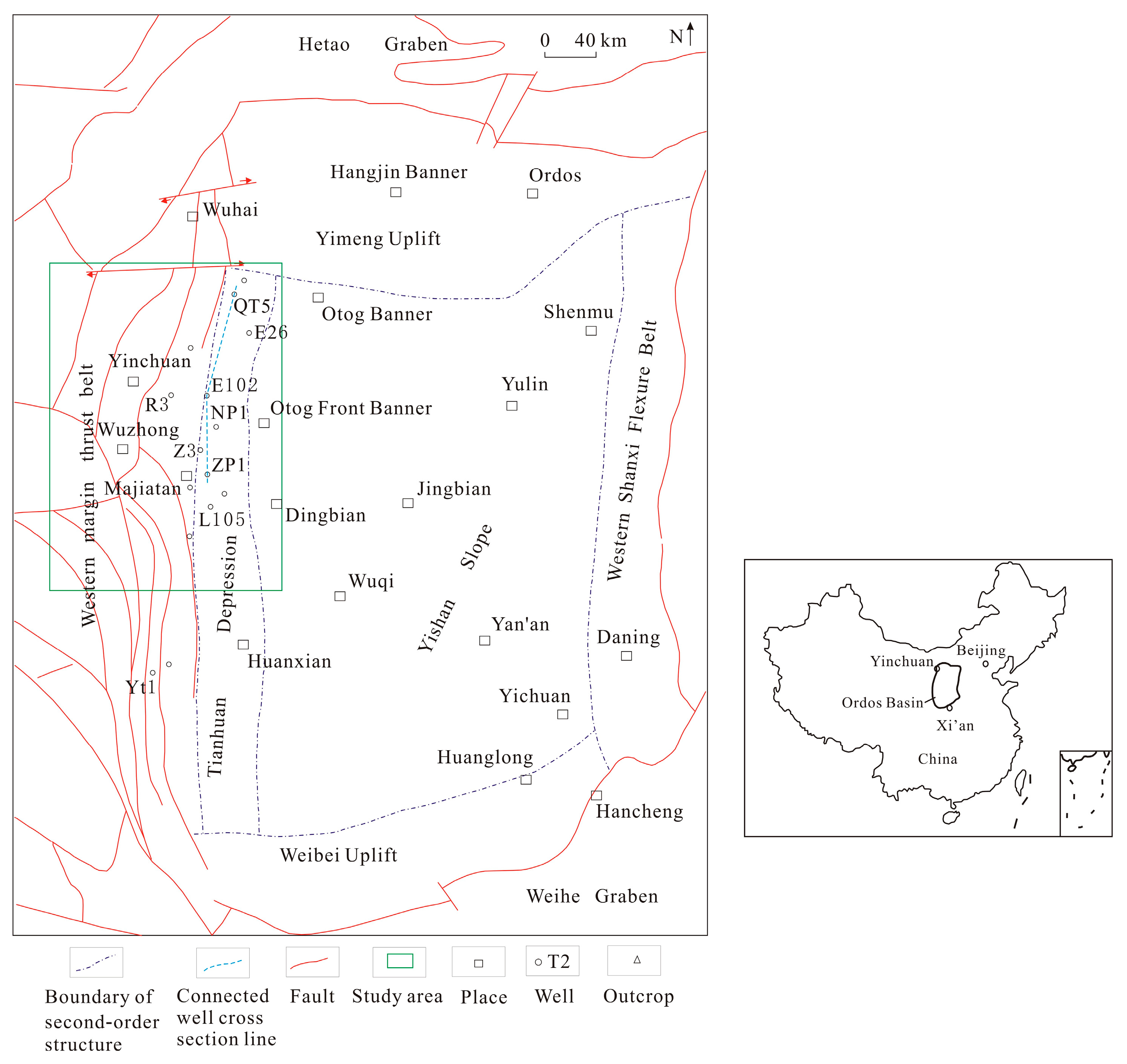
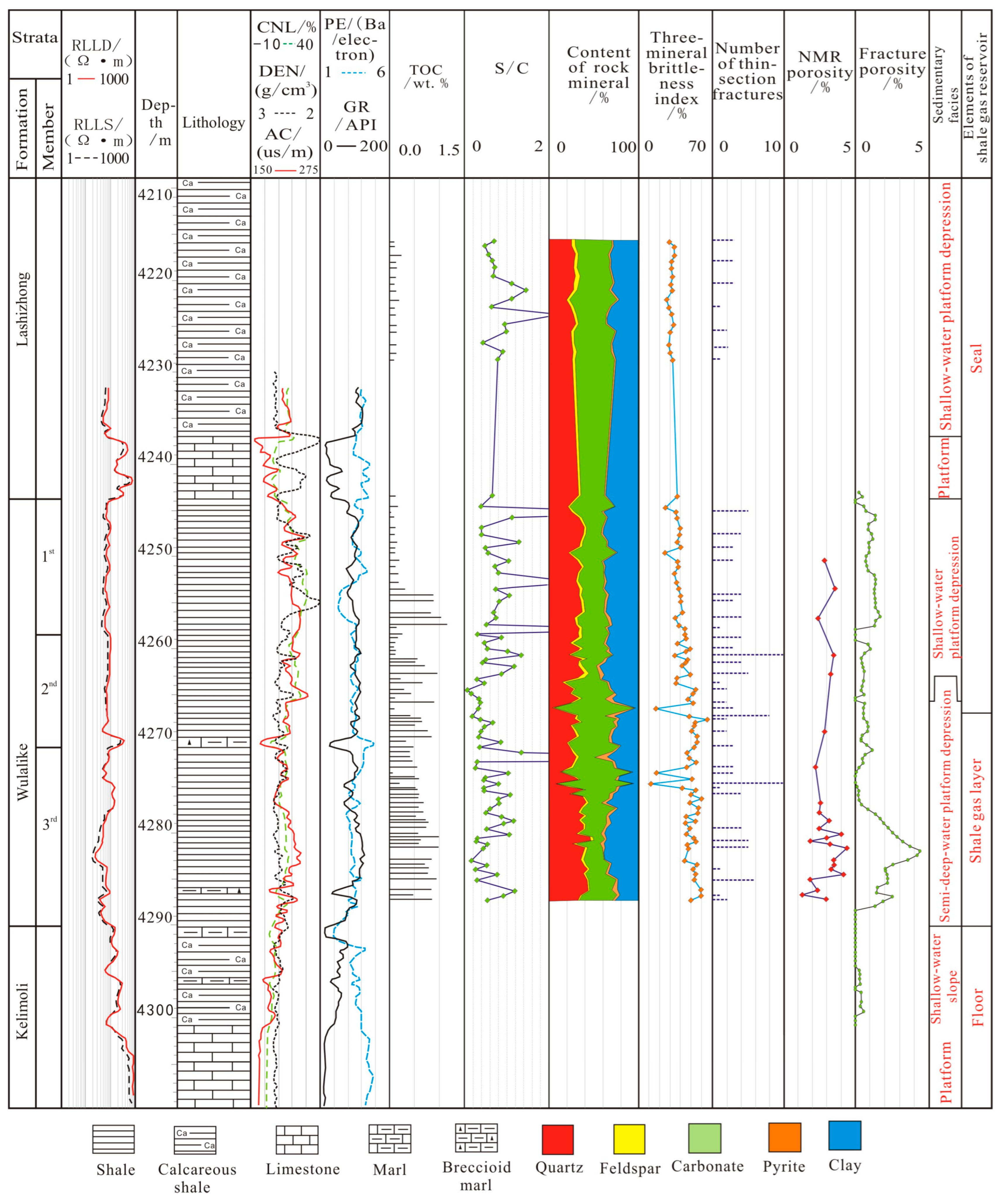
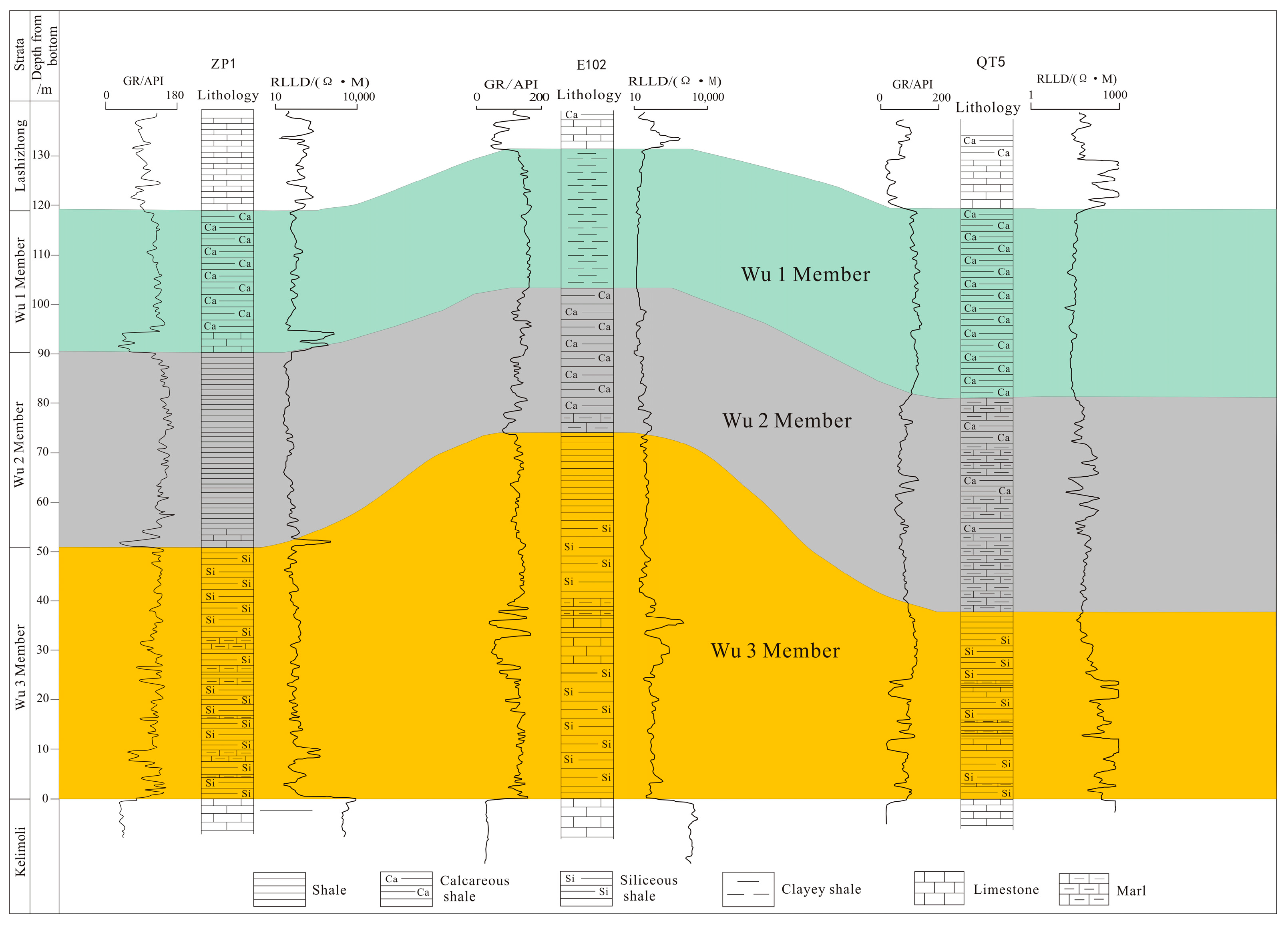
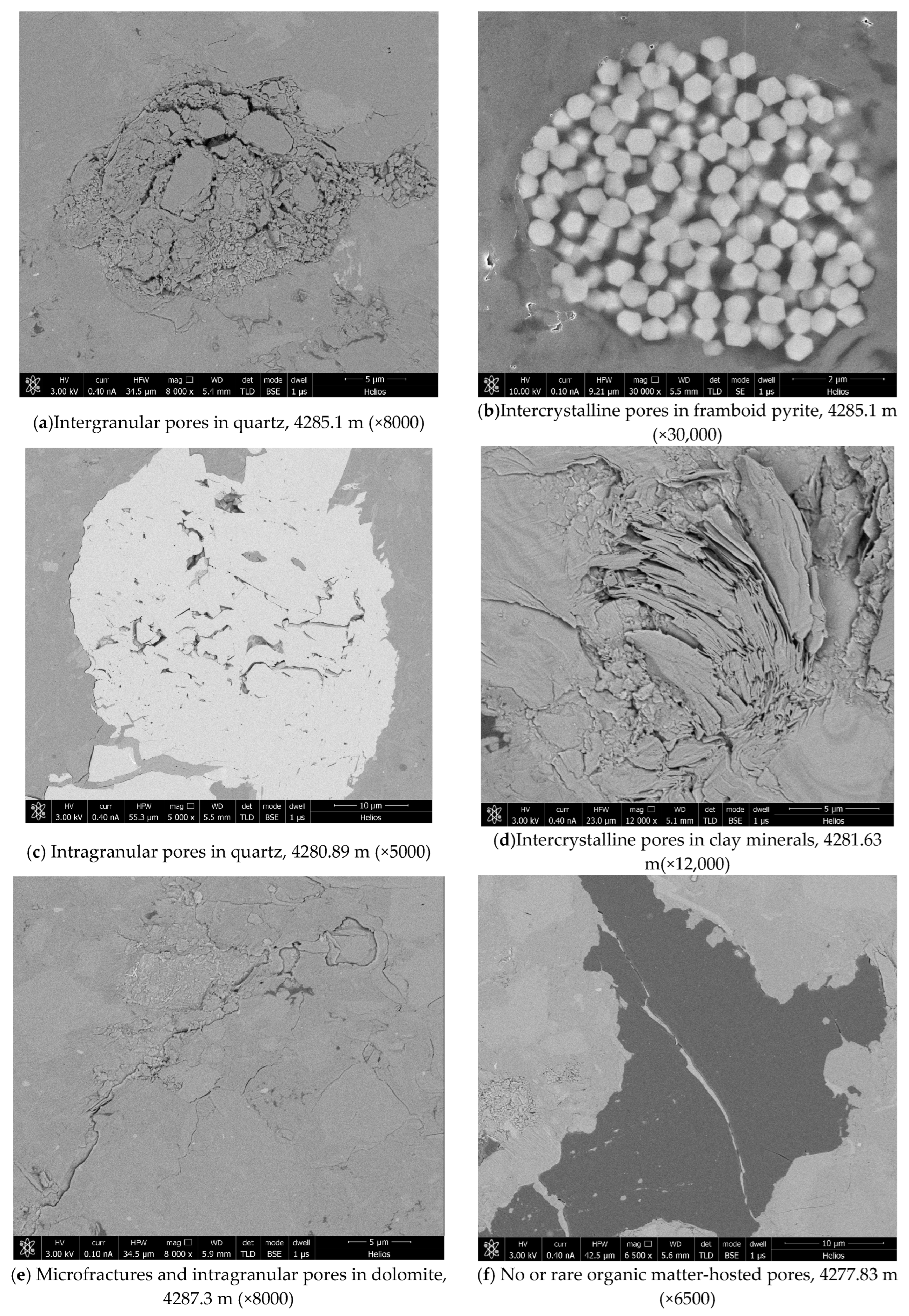
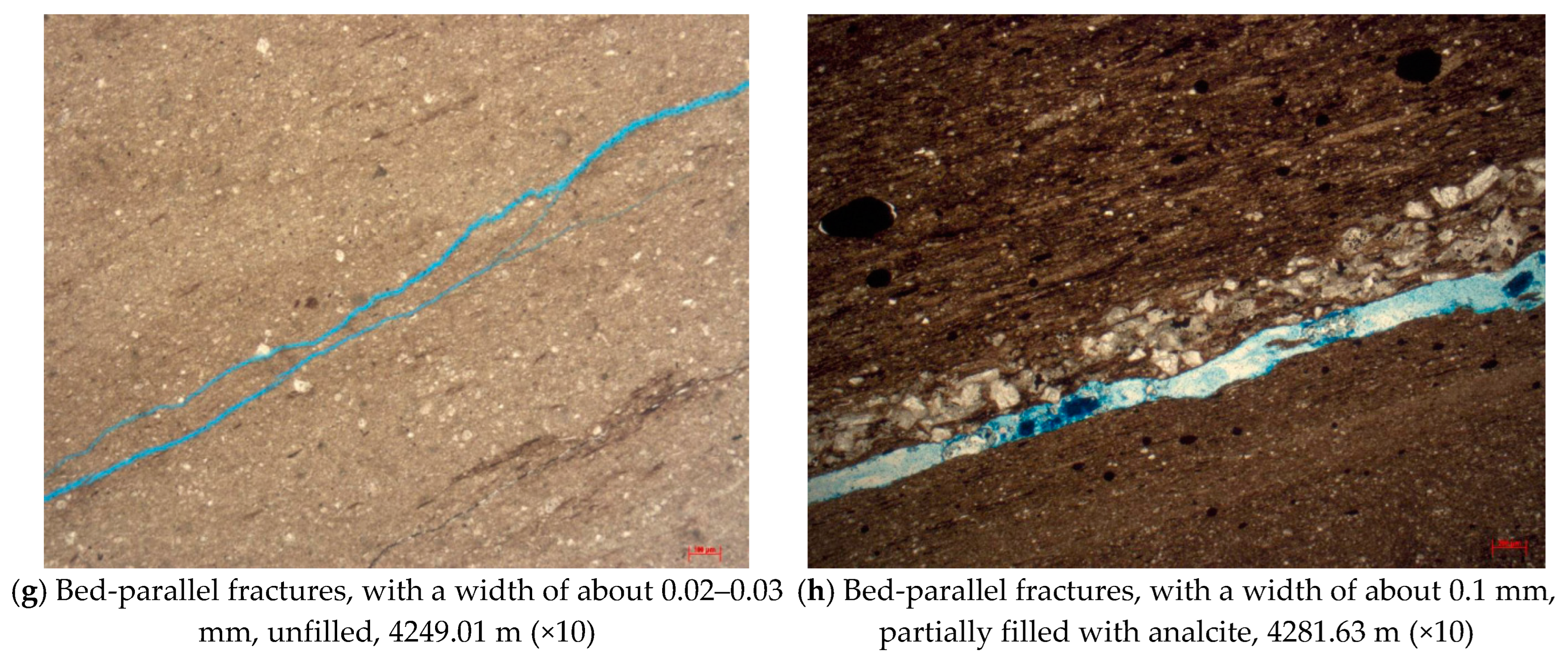
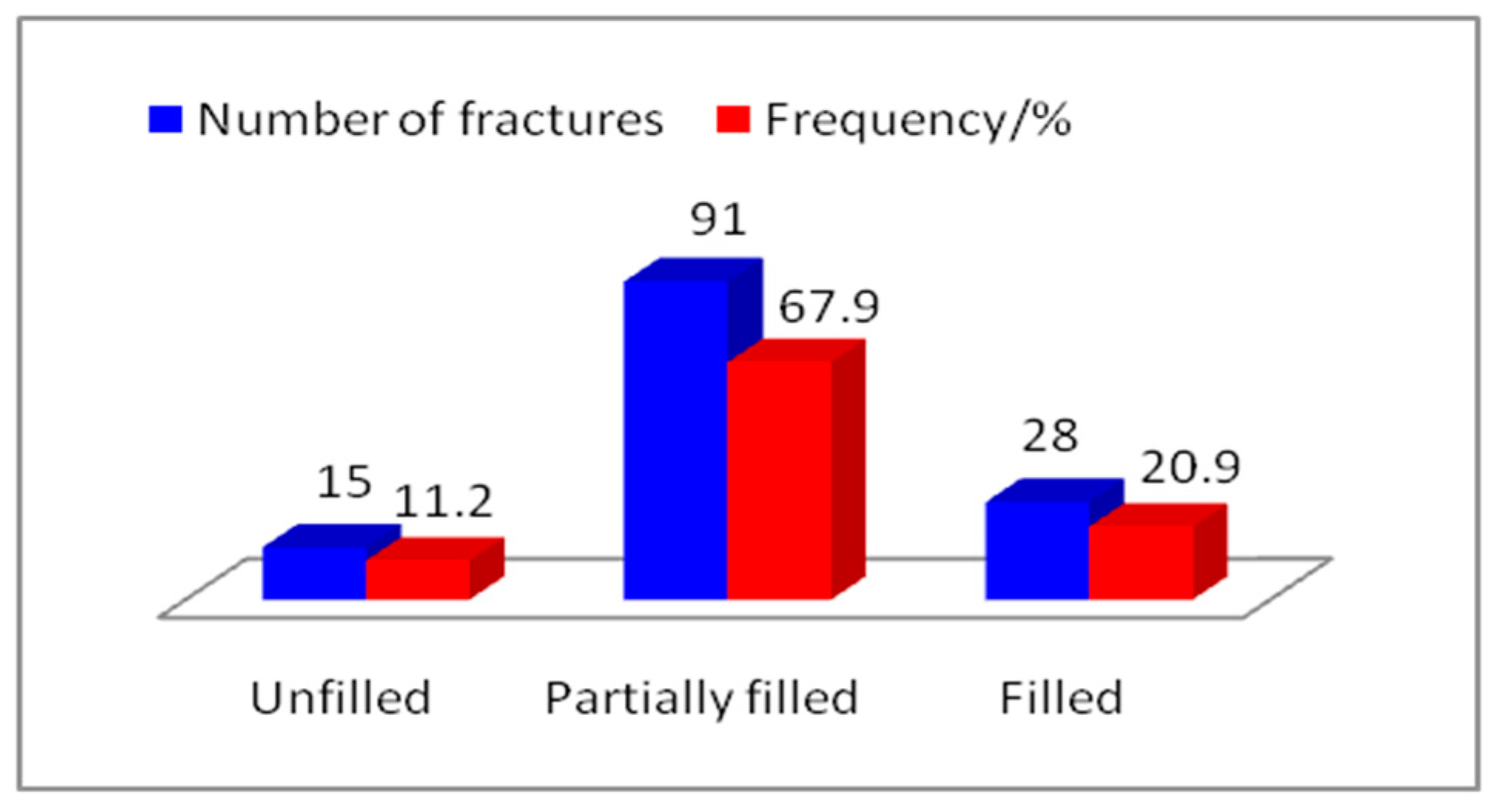
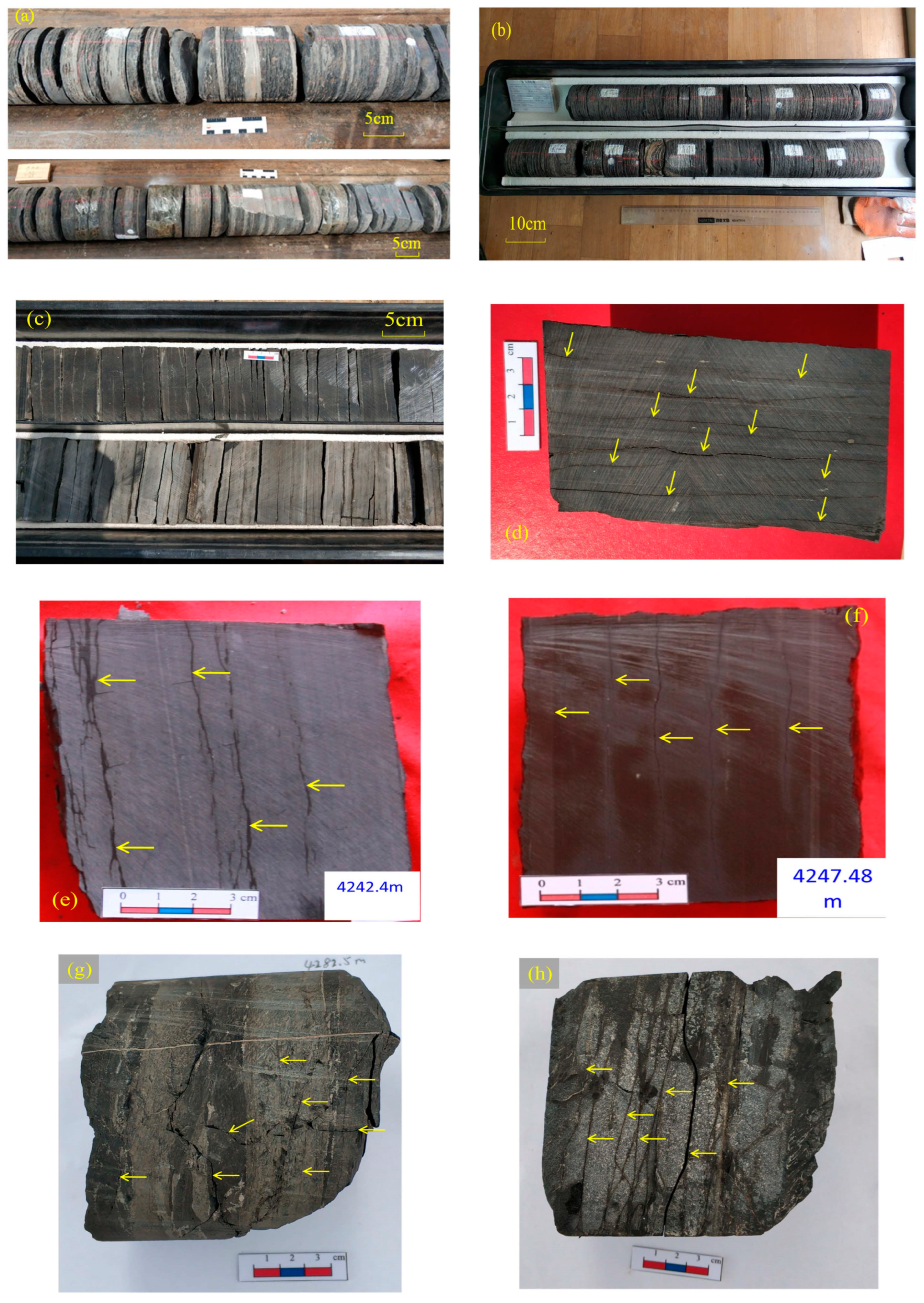
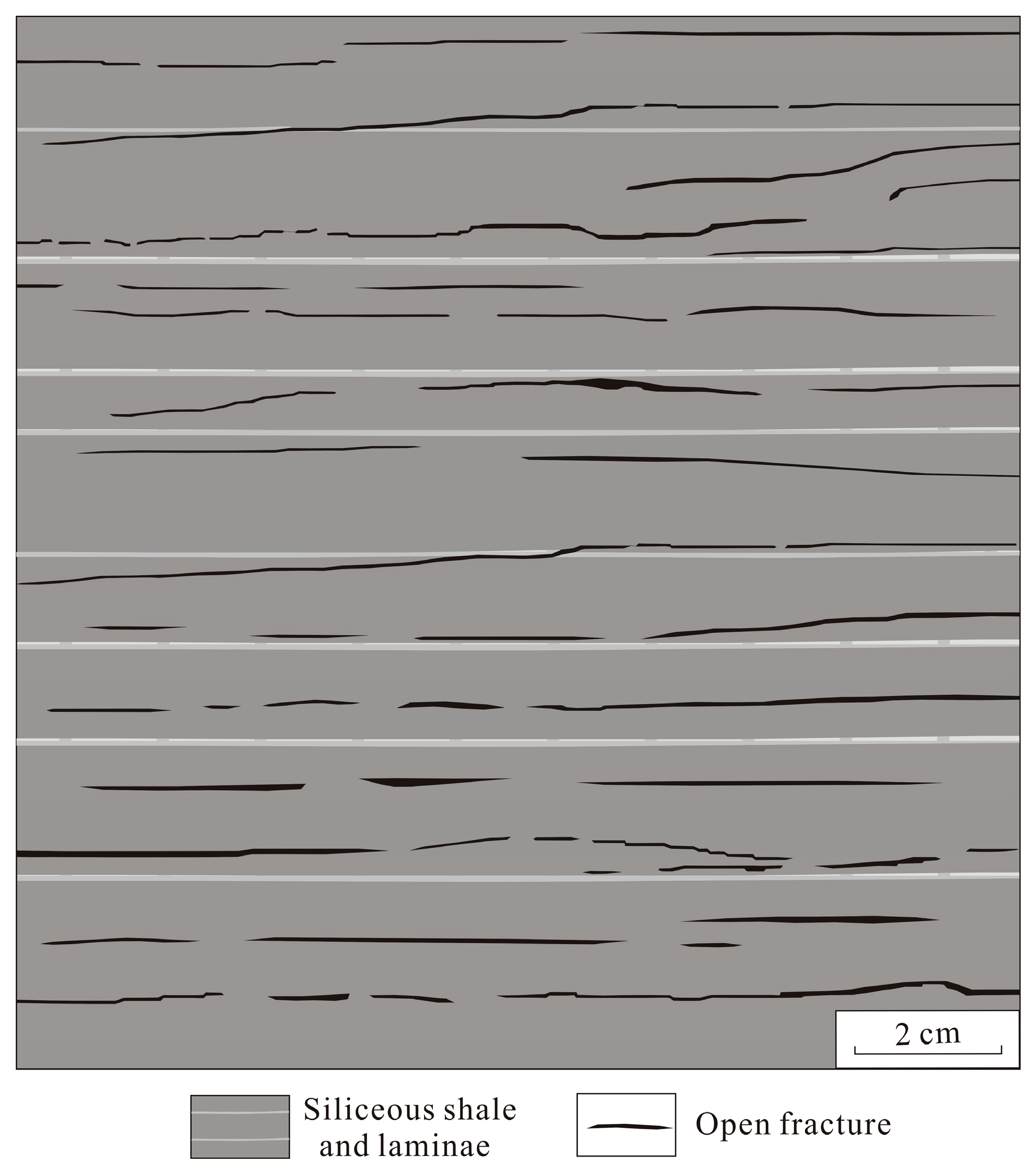

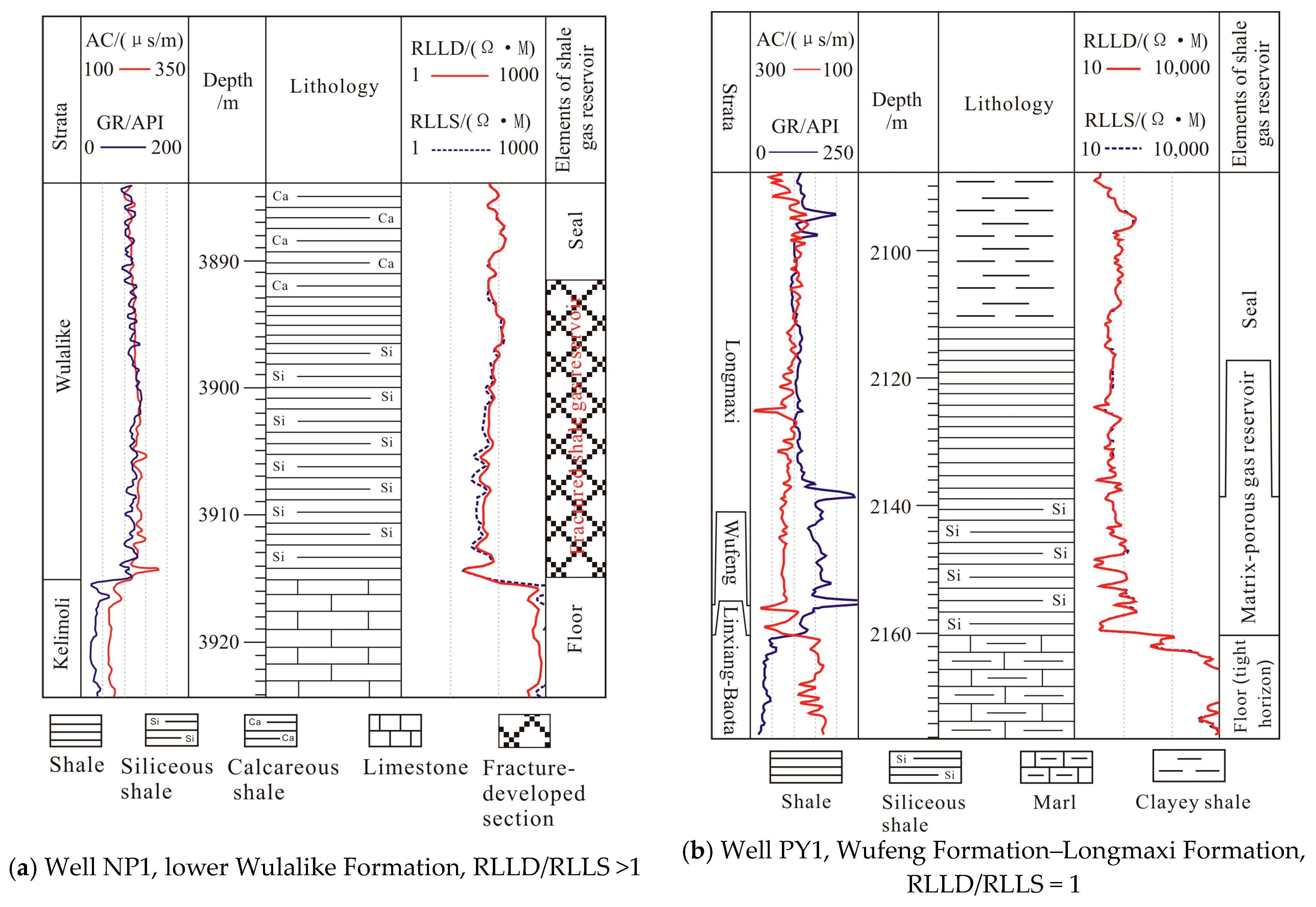
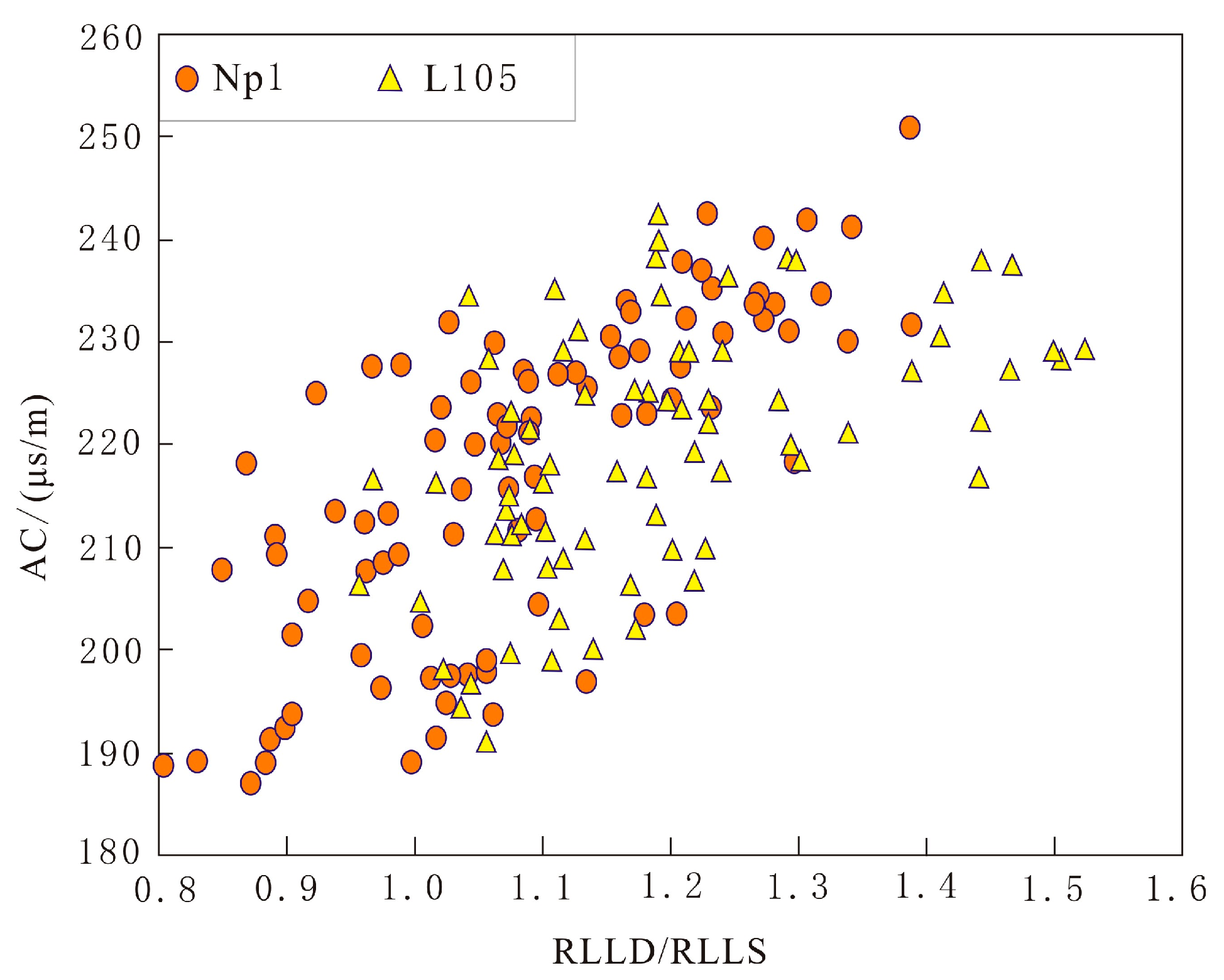
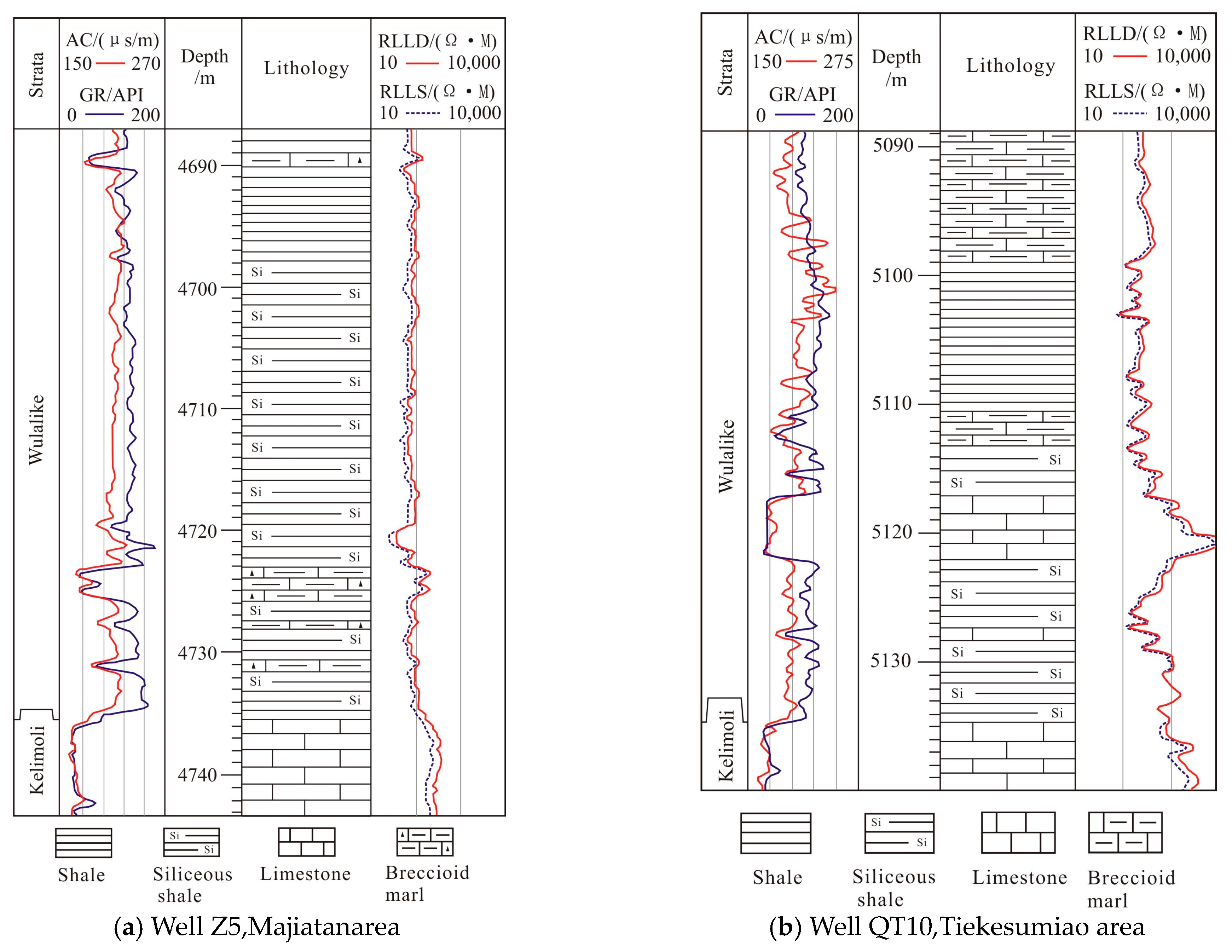
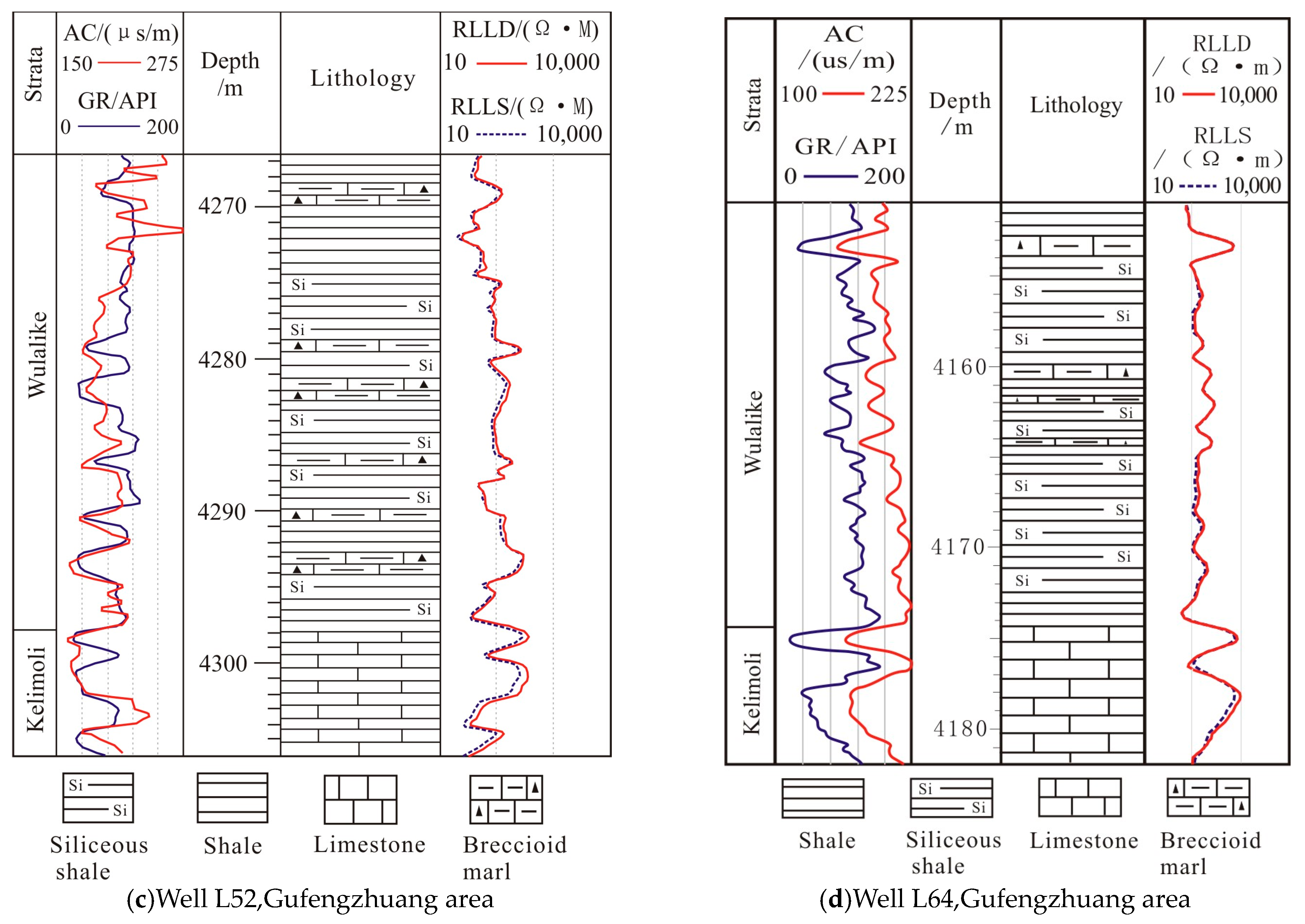
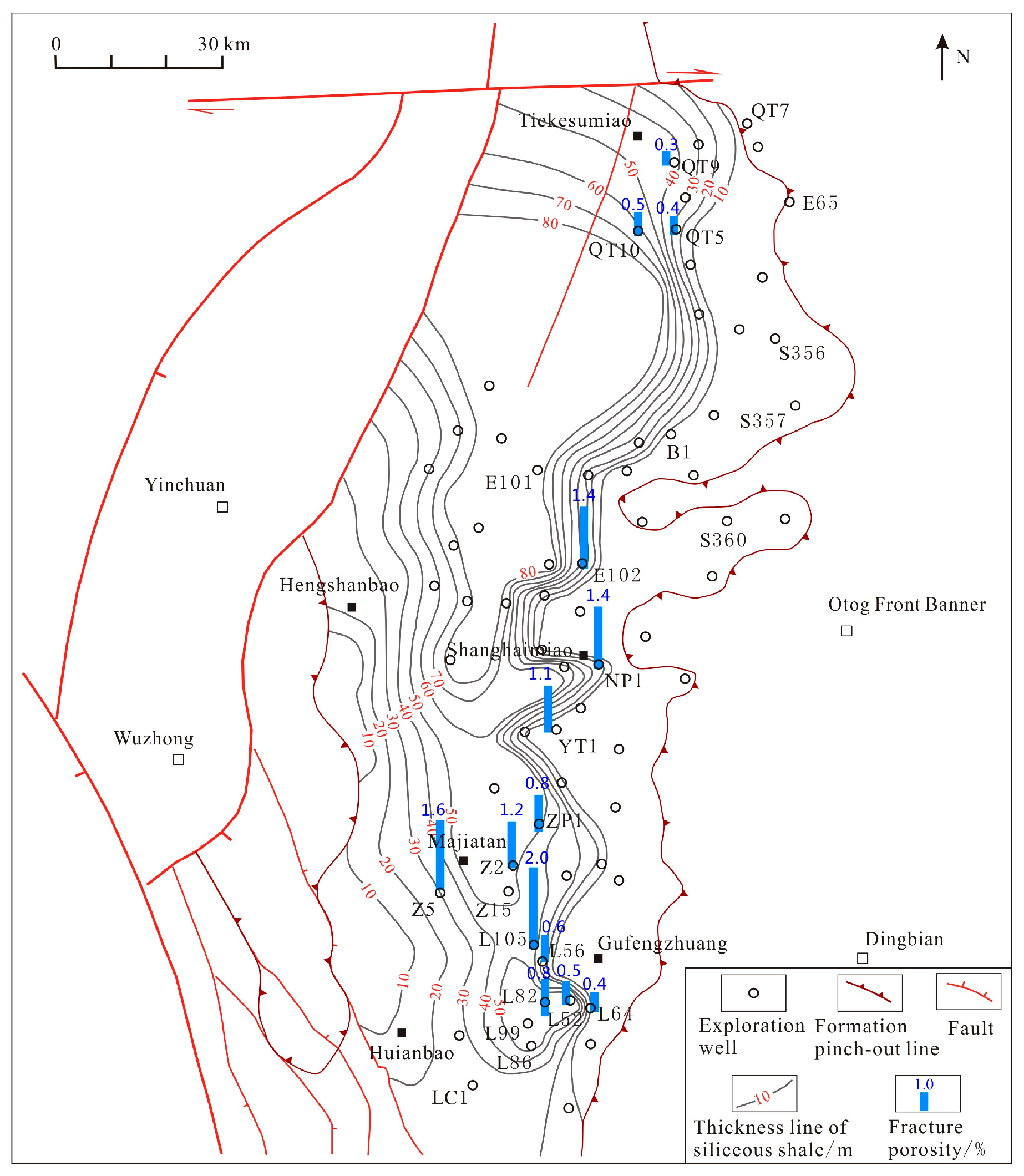
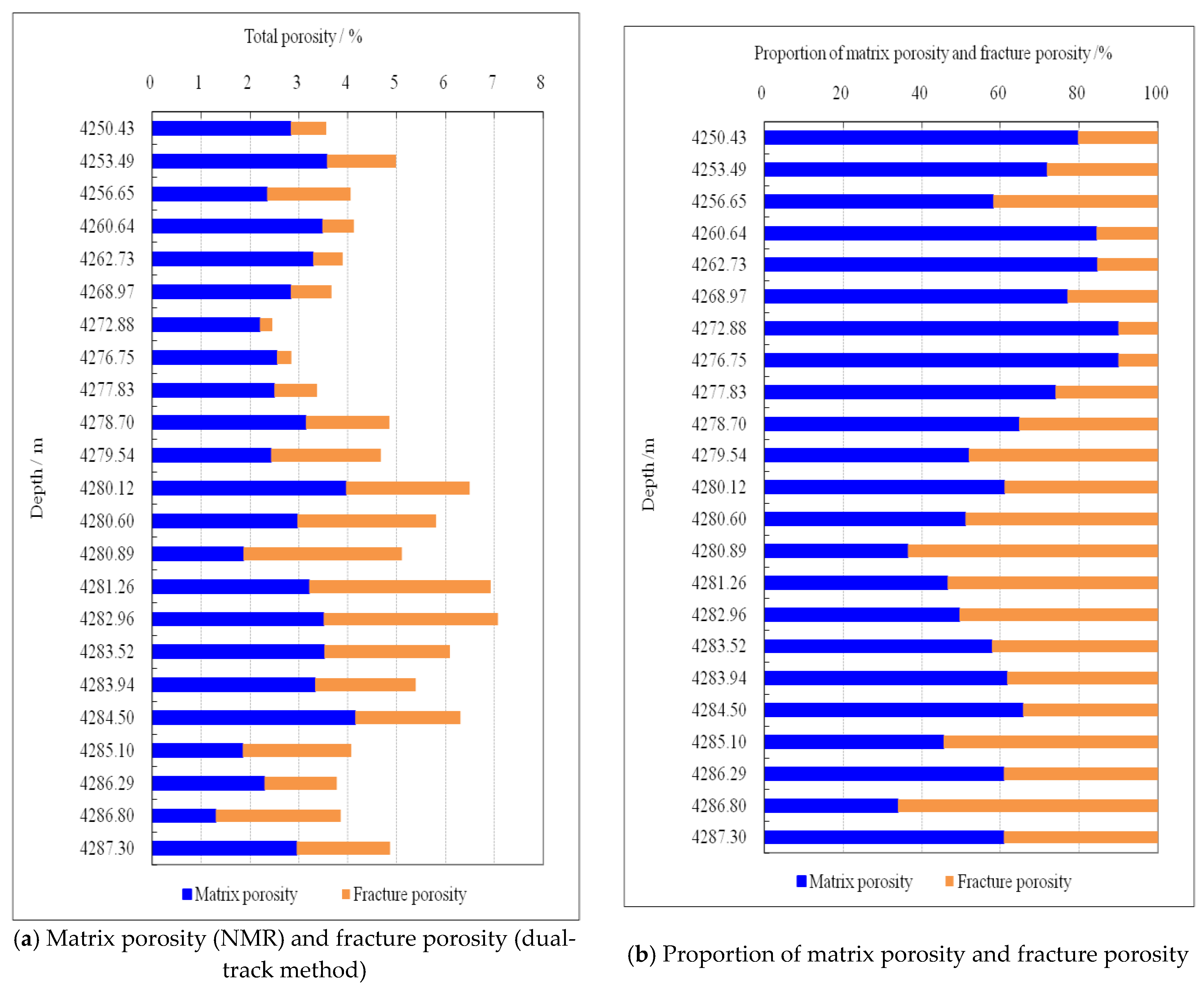
| No. | Method | Description | Advantages | Disadvantages |
|---|---|---|---|---|
| 1 | Section/core observation | Used to visually observe the dimension (length and width), occurrence, and filling of fractures in rock samples and calculate fracture density | Suitable for describing macrofractures with a width of 0.1 mm or more and estimating fracture porosity | Difficult to identify and characterize microfractures with a width of ˂0.1 mm and their filling status |
| 2 | Imaging logging | Used to identify the dimension (length and width), occurrence, and filling of fractures by using imaging techniques such as microresistivity and array acoustic, and calculate fracture density | Suitable for describing macrofractures with a width of >5 mm | Not applicable to identify fractures with a width of ˂1 mm and calculate fracture porosity |
| 3 | Conventional resistivity logging | Used to identify the length of fracture zone in tight rocks according to the significant difference in response values of deep and shallow resistivities caused by mud invasion during drilling (known as RLLD/RLLS dual-track anomaly) and calculate fracture porosity | Suitable for fracture zones in tight rocks with severe mud intrusion | Not applicable to fracture zones in tight rocks without mud invasion |
| 4 | Rock thin section/high-precision SEM | Used to visually observe the dimension (length and width) and filling of microfractures and calculate fracture density | Suitable for describing microfractures and determining pore types | Highly dependent upon observation points and does not quantitatively calculate the fracture porosity |
| 5 | Porosity-permeability chart | Used to measure the porosity and permeability of rock samples using methods such as helium gas and mercury injection and qualitatively determine the type of pores/fractures based on the correlation between porosity and permeability and the degree of pore permeability | Qualitatively identify microfractures, determine pore types, and generate reliable results | Cannot calculate fracture porosity; high requirement for sample size |
| 6 | NMR | Used to measure the porosity and permeability of rock using NMR signals of hydrogen atoms of pore fluids in rock samples and indirectly determine the pore/fracture types according to the features of standard T2 spectra. | Qualitatively identify microfractures, determine pore types, and generate reliable results; low requirement for sample size | Cannot calculate fracture porosity |
| 7 | Dual-porosity media model | Used to establish a petrophysical model of pore composition based on experimental data and calculate the rock porosity and its main components | Quantitatively obtain the fracture porosity, determine the type of gas reservoir, and identify the main pay zones. Especially suitable for shale formations with TOC >2% | Highly dependent upon data points and test results, as well as key parameter calibration values. Difficult to characterize shale with an average TOC of ˂1% |
| Core | Well | Depth/m | Avg. Fracture Width/mm | Avg. Fracture Spacing/ cm | Fracture Number per Cubic Meter of Shale | Fracture Volume per Cubic Meter of Shale/(m3) | Fracture Porosity/ % |
|---|---|---|---|---|---|---|---|
| 1 | L99 | 4422–4432 | 0.1 | 2 | 50 | 0.0050 | 0.50 |
| 2 | L99 | 4422–4432 | 0.1 | 0.8 | 125 | 0.0125 | 1.25 |
| 3 | L99 | 4422–4432 | 0.1 | 0.5 | 200 | 0.0200 | 2.00 |
| 4 | L99 | 4422–4432 | 0.1 | 1.2 | 83 | 0.0083 | 0.83 |
| 5 | L105 | 4284–4285 | 0.1 | 1 | 100 | 0.0100 | 1.00 |
| 6 | ZP1 | 4273–4274 | 0.1 | 0.75 | 133 | 0.0133 | 1.33 |
| 7 | ZP1 | 4247–42,748 | 0.15 | 2.5 | 40 | 0.0060 | 0.60 |
| Well | Depth/m | m | RLLS/(Ω·m) | RLLD/(Ω·m) | Φfr/% | Rmf/(Ω·m) |
|---|---|---|---|---|---|---|
| L105 | 4284–4285 | 1.4 | 52.70 | 75.98 | 1.00 | 0.27 |
| ZP1 | 4273–4274 | 1.4 | 84.057 | 91.01 | 1.33 | 2.60 |
| 4247–42,748 | 1.4 | 40.064 | 47.685 | 0.60 | 0.19 |
| Area | Well | Depth/m | Thickness/m | RLLS/(Ω·m) | RLLD/(Ω·m) | RLLD/RLLS | Φfr/% | Remarks |
|---|---|---|---|---|---|---|---|---|
| Majiatan | Z5 | 4700–4735 | 35 | 24.7–148.6/62.6 | 32.2–197.5/82.3 | 1.25–1.38/1.31 | 0.84–2.91/1.58 | Dual-track interval occurs continuously, with large thickness and high amplitude |
| Z2 | 4111–4122 | 11 | 56.7–174.1/108.5 | 66.8–246.8/153.6 | 1.04–1.91/1.41 | 0.29–1.82/1.17 | Dual-track interval is intermittent, mainly in three sections | |
| 4129–4132.5 | 3.5 | 33.6–111.8/83.2 | 46.0–126.5/92.7 | 1.00–1.37/1.14 | 0.06–2.60/0.87 | |||
| 4137–4139 | 2 | 62.7–125.5/91.8 | 73.3–144.6/103.1 | 1.02–1.17/1.12 | 0.17–1.06/0.65 | |||
| ZP1 | 4235–4252 | 17 | 19.9–87.7/47.5 | 24.0–90.8/54.2 | 1.02–1.27/1.16 | 0.31–2.71/1.34 | The dual-track feature is mainly found in two sections | |
| 4262–4283 | 21 | 32.2–221.2/70.1 | 34.8–239.5/75.3 | 1.00–1.09/1.07 | 0.01–1.09/0.65 | |||
| Shanghaimiao | YT1 | 3976–3999.5 | 23.5 | 42.1–184.9/86.8 | 49.2–450.2/145.9 | 1.07–2.53/1.60 | 0.49–2.49/1.46 | Dual-track interval mainly appears at the bottom, with greatly variable amplitude, which decreases downward |
| E102 | 3622–3645 | 23 | 17.3–38.9/24.6 | 20.4–45.8/29.6 | 1.13–1.30/1.20 | 1.53–3.14/2.43 | Separated by marl, the dual-track interval is mainly distributed in the upper and lower parts | |
| 3664–3689 | 25 | 22.6–77.9/45.8 | 23.5–95.9/53.9 | 1.03–1.24/1.18 | 0.35–2.09/1.38 | |||
| NP1 | 3897–3905 | 8 | 48.9–97.2/64.4 | 60.3–109.4/75.6 | 1.06–1.28/1.19 | 0.45–1.61/1.14 | Dual-track interval distributes continuously, with the amplitude increasing downward | |
| 3905–3914 | 9 | 27.9–75.7/42.4 | 33.6–79.0/75.7 | 1.03–1.39/1.25 | 0.37–2.84/1.81 | |||
| Gufengzhuang | L56 | 4187–4189 | 2 | 45.0–98.0/70.0 | 47.0–100.0/76.0 | 1.04–1.25/1.09 | 0.19–1.38/0.57 | Dual-track interval only appears in local shales, with a thickness of 2 m |
| L82 | 4364–4368 | 4 | 19.0–50.0/38.0 | 22.0–60.0/40.0 | 1.02–1.20/1.12 | 0.30–1.85/0.71 | Dual-track interval only appears in local shales, with a thickness of 4 m | |
| L52 | 4275–4298 | 24 | 36.3–265.4/117.6 | 39.0–290.9/129.5 | 1.03–1.44/1.09 | 0.13–1.20/0.50 | Dual-track interval distributes continuously, with a large thickness but relatively low amplitude | |
| L64 | 4155–4158.5 | 3.5 | 105.0–150.0/120.0 | 120.0–170.0/130.0 | 1.01–1.14/1.08 | 0.10–0.66/0.43 | The dual-track interval appears intermittently, mainly in two sections | |
| 4165–4173 | 8 | 100.0–200.0/130.0 | 110.0–210.0/140.0 | 1.01–1.10/1.08 | 0.21–0.55/0.38 | |||
| L105 | 4275–4288 | 13 | 18.6–146.8/61.0 | 26.4–155.1/74.8 | 1.02–1.52/1.31 | 0.14–4.38/2.00 | Dual-track interval mainly occurs at the bottom, with a thickness of 13 m | |
| Tiekesumiao | QT10 | 5099–5117 | 18 | 103.3–407.0/212.6 | 112.3–533.4/261.0 | 1.04–1.31/1.21 | 0.21–0.88/0.53 | Dual-track feature is observed in all black shales, with a cumulative thickness of 27 m and high amplitude |
| 5122–5131 | 9 | 133.3–1009.3/522.8 | 149.2–1193.0/613.3 | 1.03–1.32/1.17 | 0.06–0.50/0.27 | |||
| QT9 | 4717–4739 | 22 | 68.4–440.2/135.6 | 72.2–498.9/145.2 | 1.00–1.17/1.06 | 0.00–0.63/0.31 | Dual-track interval only occurs in local shales with low amplitude | |
| QT5 | 4670–4677 | 7 | 46.2–163.3/95.8 | 46.5–183.5/106.3 | 1.01–1.20/1.10 | 0.13–0.80/0.52 | Dual-track interval occurs intermittently in three shale sections, 6–9.5 m thick in each section, with low amplitude | |
| 4682.5–4688.5 | 6 | 100.6–419.5/232.8 | 104.3–473.6/253.6 | 1.02–1.17/1.08 | 0.12–0.36/0.25 | |||
| 4693.0–4702.5 | 9.5 | 124.0–692.9/336.1 | 130.5–881.0/410.0 | 1.03–1.27/1.15 | 0.25–0.41/0.30 |
Disclaimer/Publisher’s Note: The statements, opinions and data contained in all publications are solely those of the individual author(s) and contributor(s) and not of MDPI and/or the editor(s). MDPI and/or the editor(s) disclaim responsibility for any injury to people or property resulting from any ideas, methods, instructions or products referred to in the content. |
© 2023 by the authors. Licensee MDPI, Basel, Switzerland. This article is an open access article distributed under the terms and conditions of the Creative Commons Attribution (CC BY) license (https://creativecommons.org/licenses/by/4.0/).
Share and Cite
Wang, Y.; Zhou, S.; Liang, F.; Huang, Z.; Li, W.; Yan, W.; Guo, W. Reservoir Space Characterization of Ordovician Wulalike Formation in Northwestern Ordos Basin, China. Processes 2023, 11, 2791. https://doi.org/10.3390/pr11092791
Wang Y, Zhou S, Liang F, Huang Z, Li W, Yan W, Guo W. Reservoir Space Characterization of Ordovician Wulalike Formation in Northwestern Ordos Basin, China. Processes. 2023; 11(9):2791. https://doi.org/10.3390/pr11092791
Chicago/Turabian StyleWang, Yuman, Shangwen Zhou, Feng Liang, Zhengliang Huang, Weiling Li, Wei Yan, and Wei Guo. 2023. "Reservoir Space Characterization of Ordovician Wulalike Formation in Northwestern Ordos Basin, China" Processes 11, no. 9: 2791. https://doi.org/10.3390/pr11092791
APA StyleWang, Y., Zhou, S., Liang, F., Huang, Z., Li, W., Yan, W., & Guo, W. (2023). Reservoir Space Characterization of Ordovician Wulalike Formation in Northwestern Ordos Basin, China. Processes, 11(9), 2791. https://doi.org/10.3390/pr11092791







